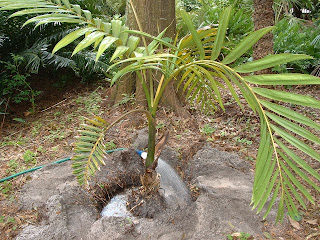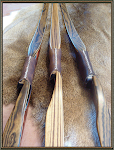Wednesday, August 27, 2008
Today Brandan and I cleaned up some areas that were affected by Fay and we transplanted a Red Feather Palm Tree ( Chambeyronia macrocarpa ) that was originally planted in the sun. These Palm Trees are much more happy in the shade. Some other names for this Palm Tree are Houailou Red Leaf Palm,Blushing Palm Tree and the Flamethrower Palm Tree. This Palm does not get very tall, they grow to heights of about 6 feet. This one wasn't looking at it's best so we thought it would be best to move it. We have documented today's transplant and I will show you step-by-step how we did it.









Tuesday, August 26, 2008
Mowing height is probably the most important part of mowing. Most grasses manufacture sugars through the process of photosynthesis so they can collectively develop into a high quality lawn. If you mow your grass at low heights then you leave limited leaf area to sustain the photosynthesis rate that is necessary to maintain good vigor. Basically, a lawn mowed too short will have a shallow root system with little total root mass. This is something I notice a lot of. Mowing height can play an important role in preventing weeds from developing. I have heard that higher mowing heights resulted in less weeds . The reason for this is that higher grass provides more shading and competition to the weed seedlings during germination.
When mowing your grass you should adhere to the 1/3" mowing rule. You should not have a time when you mow your lawn, like once a week or twice a week. Your lawn will grow at different rates at different times. The best thing you can do is follow the 1/3" mowing rule. To get your recommended lawn height you need to look up your grass type and recommended growth heights. An example of the 1/3" mowing rule is if your grasses recommended height is normal at 2 inches, the height of your grass should not be allowed to grow beyond 3 inches before it is mowed back down to 2 inches. If 1 inch is mowed off, then 1/3 of the total blade length is removed and the 1/3" mowing rule has been followed properly.
With that being said, if you follow the general 1/3" mowing rule, you will have a very nice lawn. Of course regular watering and fertilizer aren't going to hurt either. So remember, break your habit of mowing the same day all the time and start listening to your lawn and only mow when it is necessary.
I hope you found this post useful. Se you again next Tuesday!
Labels: Proper Lawn Mowing Heights, Tuesday Tips
Monday, August 25, 2008
When the fruit of a Passion Vine is ripe it is a yellow-green color and is about the size of a small egg. You can eat the yellow pulp and it tastes sweet. The delicious fruit and flowers may be eaten raw or cooked in jellies, and the leaves are eaten in salads. To some the Passion Vine is an invasive annoyance. They just don't know the power that this vine holds. I will now go over some of the Pros and Cons of the Passion Flower Vine.
- Beautiful fragrant flowers
- Delicious fruit
- Very low maintenance
- Medicinal
- Recent studies have pointed to the flavonoids in the passion flower vine as being the primary constituents responsible for its relaxing and anti-anxiety effects.
- Some of the plants constituents, Apigenin, Luteolin, Kaempferol, and Quercetin, are being studied and are showing promise in fighting Parkinson's Disease, Cancer, HIV, and Leukemia.
- The leaves and stems are medically used as anti-spasmodic, astringent, diaphoretic, hypnotic, narcotic, sedative, vasodilator and are also used in aiding the treatment of women's complaints.
- The Passion Flower Vine is also used as an alternative medicine in the treatment of insomnia, nervous tension, irritability, neuralgia, irritable bowel syndrome, premenstrual tension and vaginal discharges.
- An infusion of the plant depresses the motor nerves of the spinal cord, this makes it very valuable in aiding the treatment of back pain.
- The infusion is also a sedative and slightly reduces blood pressure and increases the respiratory rate.
- This herb contains alkaloids and flavonoids that are an effective non-addictive sedative that does not cause drowsiness.
- It is also of great service in epilepsy.
- Here is an Herbal Tea recipe to help with late night restlessness: take 1 tbsp dried herb and add it to 1 cup boiling water and let imbue for 10 minutes. Drink this aromatic, flavorful medicinal tea just before bedtime and you should sleep like a baby.
- Invasive
- Do not consume or use if pregnant
Looks like the pros out weigh the cons on this one too. To those who think this vine is invasive, do you know what it is? If you grow it in a pot you should be alright. Besides, it seems like a small price for all of the benefits it has. Here are some pictures of my Purple Passion Flower Vine.




Disclaimer: This post was designed to teach about herbs, wild herb conservation, historical uses and latest herb research. This information is presented for educational use only. It is not meant to diagnose, cure, treat or prevent any disease. Please discuss your health issues as well as herb and supplement use with your doctor.
Sunday, August 24, 2008
Today was the first day that I took my son to the beach. He had a great time soaking up the sun, but he got hot so quick he jumped out of his suit right when we got there. The following pictures are of my sons first day at the beach right after Fay has left us.




Labels: baby, Tropical Storm Fay
Saturday, August 23, 2008





Thursday, August 21, 2008
While it was bad, it seemed like just another rain storm to me after sticking out Hurricane Frances, Hurricane Jean and Hurricane Wilma. Those were some bad storms, they even made the top ten worst Hurricanes list. I am glad I wasn't gardening back then, I would have lost everything. I had lots of damage in those Hurricanes. I tell you what though, those were some of the best times of my life. It is amazing to see how everyone pulls together in times like that. Everybody helping each other and setting aside their differences for the greater good. I could do a whole post itself about those times. Maybe if I get enough requests for it I will do one.
Back to Fay, I can now see the sun peeking out from behind the clouds to help soak up some of this water. It is about time, I haven't seen the sun in days. I can't take to much of that, I think I draw my energy from the sun and without it I am powerless. Lol!! My dad's house in Lakewood Park Florida is surrounded by water. I can't make it over there in my car, but I saw the helicopter cam on the news last night and MAN is it flooded there. They may have had the worst flooding around. It will take a while for them to dry out.
Well the sun has just disappeared again and that's my que to go back outside and clean up some more. Have a great day!!
Labels: Storms, Tropical Storm Fay
Tuesday, August 19, 2008
While on my little venture to the store I noticed a few trees that had been blown over by the wind and lots of garbage cans everywhere. It was difficult to travel around in a car, every corner was flooded and there was debris all over. I would say from my experience in the last Hurricanes that Tropical Fay did her thing. I did not expect to see as much damage as I did. Personally I didn't think it was bad at all here in Fort Pierce Florida. We had lots of rain and lots of wind but the wind was not very strong,I just thought that it lasted forever. All in all, we needed the water, it may be enough to lift all the bans.
Tropical Storm Fay is dying out but is soon to hit water again and may become a boomerang storm which could mean trouble for the north eastern coastline. No one is sure yet exactly what Fay will do but with any luck everyone is preparing themselves for the storm. I wish everyone good luck.
Here are some pictures I took from my yard during Tropical Storm Fay.
This one is my little Mangoes hanging on for dear life.

The following 2 pictures are of my neighbors Papaya Trees that went down in the winds.


This is a picture of my pond area.

Here is my baby Pandanas utilis or Screw Pine getting flooded.

Here is a picture of my back yard starting to flood. It is about 8 inches deep in this picture.

These are my neighbors Palm Trees swaying in the wind.

Here is another picture of my back yard starting to flood. Oh boy!

Labels: Storms, Tropical Storm Fay
Monday, August 18, 2008
The first major rule to pruning Palm Trees is to avoid pruning them at all. Palm Trees are designed to shed their fronds on their own. Just because a Palm frond is turning colors or maybe even browning does not mean that it is done contributing to the tree. The browning of fronds is a process called Trans location of Nutrients meaning that the Palm Tree is recycling the nutrients of the frond back into the heart of the Palm Tree itself. If you remove the fronds during this process then you weaken the Palms defenses against molds and fungi. Allowing the process of self-pruning or self-cleaning is especially important to the species of Palm Trees with a "crown shaft" which is a green shaft located just below the fronds.
If it is necessary to prune the Palm Tree then a general rule is applied to Palms that you should not cut fronds that hang below a parallel line to the ground or the 9:00 to 3:00 o'clock rule. This is called a Hurricane Cut or a Candle Cut and is very damaging the the tree. If a Hurricane cut is repeated over and over it will create a condition know as a "pencil top" which is the narrowing of the trunk just below the fronds. The name Hurricane cut comes from the fact that during Hurricane winds, the head of the Palm Tree may snap off where the thinning occurred and become airborne.
So there you have it plain and simple, just don't prune your Palm Trees and they will be happy and healthy. And remember the 9:00 o'clock to 3:00 o'clock rule if you absolutely must trim those Palm Trees. Here are some examples of Palm Tree Pruning. I did not take these pictures.
Here is a classic example of the Hurricane Cut. This technique should be avoided at all costs.

If pruning is necessary, then this is the technique you want to use. Notice how there is a line parallel to the ground. This is called the 9:00 to 3:00 O'clock rule.

I hope you found this post helpful.
This policy is valid from 18 August 2008
This blog ( A Yard In Fort Pierce ) is a personal blog written and edited by me ( Lets Plant ). For questions about this blog, please contact LetsPlant (letsplant@gmail.com).
This blog accepts forms of cash advertising, sponsorship, paid insertions or other forms of compensation.
This blog abides by word of mouth marketing standards. We believe in honesty of relationship, opinion and identity. The compensation received may influence the advertising content, topics or posts made in this blog. That content, advertising space or post will be clearly identified as paid or sponsored content.
The owner of this blog ( A Yard In Fort Pierce) is not compensated to provide his opinion on products, services, websites and various other topics. The views and opinions expressed on this blog are purely the blog owners. If I claim or appear to be an experts on a certain topic or product or service area, I will only endorse products or services that I believe, based on my expertise, are worthy of such endorsement. Any product claim, statistic, quote or other representation about a product or service should be verified with the manufacturer or provider.
This blog does not contain any content which might present a conflict of interest.
Sunday, August 17, 2008
Aloe Vera is also know as Medicinal Aloe and Savila. I am unsure of the origin of Aloe but I do know that it grows here in Florida very well. Aloe is very drought tolerant which makes it ideal for xeriscaping. Aloe grows well in sun to partial shade areas better than most but will pretty much grow anywhere. This species of Aloe does not have the sharp spines like other Aloe Plants. The spines are actually pretty soft. Aloe is edible but doesn't taste very well at all.
Aloe Vera is jam packed with lots more pros than cons. Let's weight them out real quick.
External Uses
- Sunburn Relief: To do this you carefully remove a piece of Aloe from the plant. Then you skin the piece in your hand. I always leave a piece at the end to hold on to because it is very slippery. Then rub it all over your sunburn and let it dry.
- Treatment of minor cuts and scratches: Use the same method as above
- Reducing Inflammation: Use the same method as above
- Poor Appetite: Aloe is said to aid in the loss of appetite
- Digestive Problems: Taken internally aids in the treatment of common digestive problems
- Ulcerative Colitis: Aloe is a well known anti inflammatory
- Constipation: Aloe prevents the absorption of water in the bowel making it move faster.
- Drought tolerant: Does not require regular watering
- Low Maintenance: Aloe does not need much care. You can pretty much forget about the plant and it will always be there for you.
CONS
- Cramping: If taken internally, Aloe Vera may cause painful stomach cramps.



Disclaimer: This post was designed to teach about herbs, wild herb conservation, historical uses and latest herb research. This information is presented for educational use only. It is not meant to diagnose, cure, treat or prevent any disease. Please discuss your health issues as well as herb and supplement use with your doctor.
Labels: Aloe Vera, Medicinal Monday, Medicinal Plants
Friday, August 15, 2008
Dwarf Poinciana trees only grow to heights of about 8 feet tall. If you are planting several of them you should space them about 6 feet apart. These trees are most happy when grown in full sun to partial shade and they have average water needs. If you like Royal Poinciana trees but just don't have the room for them then this is the tree for you. In the following pictures I will walk you through my potting steps.
This is my pot full of sprouts.






Labels: Dwarf Poinciana Tree, sprouts
Wednesday, August 13, 2008
When walking by these unique Palms you could barely see their trunks. So, I dug out around the trunks to give the effect that they were hovering across the ground. We also trimmed them up a bit to make them look better. There were Cardboard Palms (Zamia furfuracea ) sprouting up all over the place and Oyster Plants ( Tradescantia spathacea ) were everywhere. There were a few Date Palms( Pheonix reclinata ) that sprouted up, we removed them too. We dug up the Cardboard Palms and potted them and we pulled up the Oyster Plants and through them into the dump pile. We also trimmed some of the other Palm Trees that were in the area and pulled up a bunch of Boston Ferns too. We made a nice path that wasn't there before that allows you to walk behind the scenes. It looks very good if you ask me. The following are pictures of today's adventure.
Here are the before pictures of the European Fan Palm Tree.


























